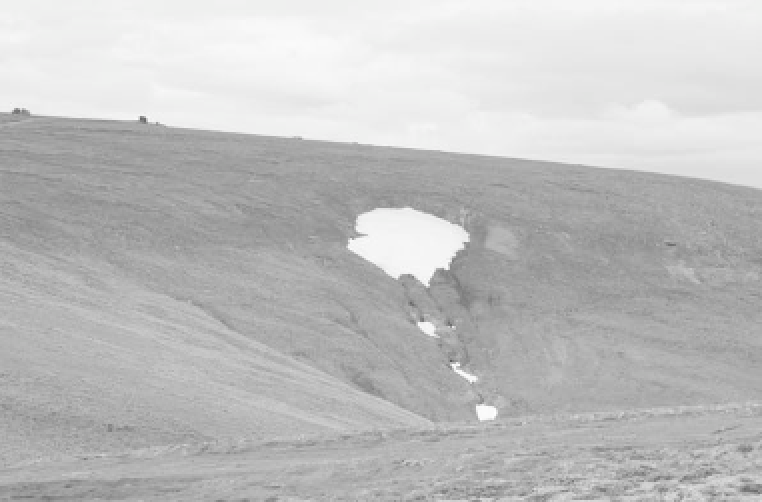Geology Reference
In-Depth Information
Plate 3.2
A nivation hollow in Old Man Range, New Zealand.
(
Photograph by Stefan Grab
)
occurs in conjunction with permafrost or seasonally
frozen ground, when it is usually referred to as gelifluc-
tion. It frequently operates with frost creep, and it is hard
to distinguish the action of the two processes.
Gelifluc-
tion
is an important process in periglacial environments,
especially on silty soils, owing to the common saturation
of the soil that results from the restricted drainage asso-
ciated with a permafrost layer or seasonally frozen water
table, and owing to moisture delivered by the thawing of
snow and ice.
existing depression. Once initiated under a snow patch,
a
nivation hollow
(Plate 3.2) increases its size and tends
to collect more snow each year, so providing an example
of positive feedback (p. 18).
Glacier processes
A glacier is a large mass of ice formed of compressed
snow that moves slowly under its own weight. Glaciers
are often classed as warm (or temperate) and cold
(or polar), according to the temperature of the ice.
Warm glaciers
have ice at pressure melting point except
near the surface, where cooling occurs in winter.
Cold
glaciers
have a considerable portion of ice below pressure
melting point. However, glaciologists now recognize that
warm and cold ice may occur within the same glacier
or ice sheet. The Antarctic sheet, for instance, consists
mainly of cold ice, but basal layers of warm ice are present
in places. A more useful distinction may be between
warm-based glaciers
, with a basal layer at pressure melt-
ing point, and
cold-based glaciers
, with a basal layer
below pressure melting point.
Nivation
This process is associated with late-lying or peren-
nial
snow patches
. It is a local denudation brought
about by the combined effects of frost action (freeze-
thaw weathering, particularly the annual freeze), chemi-
cal weathering, gelifluction, frost creep, and meltwater
flow (see Thorn and Hall 2002). It is most vigorous
in subarctic and alpine environments, where it leads
to the forming of nivation hollows as snow patches
eat into hillsides. Snow patches often start in a small

